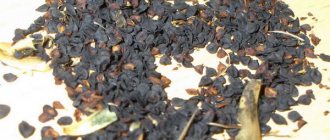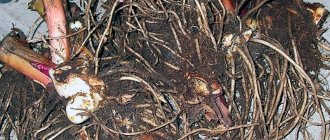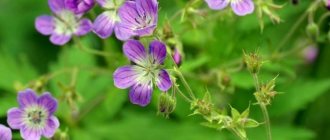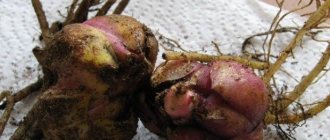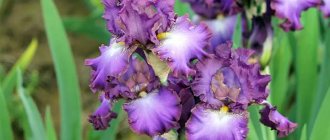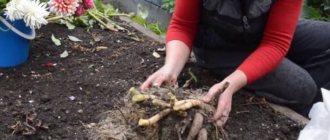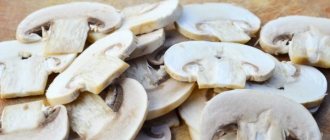Preparing for landing
The soil can be purchased ready-made in a specialized store for seedlings; it will already have all the necessary elements.
But if necessary you can make it yourself , taking sand and leaf soil in equal proportions.
The soil is sifted to remove everything unnecessary and superfluous (pebbles, twigs), and calcined in the oven at 200 degrees for 15 minutes.
Sowing of seeds is carried out in early March on the waxing moon and the following tools are needed:
The container can be any - plastic or glass - it doesn’t matter. It is important to have drainage holes through which excess water will flow out after watering.
We sow Turkish clove seeds for seedlings:
How to plant in open ground
Seeds are sown in open ground in early May . For this purpose, a warm, sunny area is selected and dug up onto the bayonet of a shovel. Mineral and organic fertilizers are applied.
Then they make holes in the soil and sow Carnation seeds. The soil is well moistened with a watering can so as not to wash out the seeds and covered with film to create greenhouse conditions so that the seeds germinate together without loss.
It is important to remove the shelter when warm weather sets in , otherwise the seedlings under it will dry out.
How to sow seeds in containers
Expanded clay is poured onto the bottom of the container, then nutritious soil , and moistened by bottom watering with warm water. Manganese should be diluted in water until it turns pink, since potassium manganese disinfects the soil.
Using a ruler, we make shallow depressions in the damp soil and seeds are sown in such rows. In the row, the distance between seeds should be 2 cm.
To ensure that the seeds germinate smoothly, the moist soil with the sown seeds is covered with glass and kept at a temperature of 17 degrees Celsius.
When most of the seeds have sprouted, the glass or other cover is removed , and further care of the seedlings consists of timely watering and rotation in relation to the sun.
By turning the seedlings to the sun in different directions, the seedlings grow more even and stocky.
Seeds are sown at a distance of 2 cm from each other, covered with earth, covered with glass or polyethylene.
Clove diseases
Caring for garden carnations includes mandatory disease prevention and getting rid of plant pests.
Unfortunately, carnations, like other flowers, are susceptible to certain diseases:
The heterosporiosis fungus attacks cloves when there is an excess of moisture and nitrogenous fertilizers in the soil. Brown spots with reddish rims appear on the leaves of the plant. The plant begins to dry out and die. In this case, the affected plants are burned and the soil is treated with Bordeaux mixture. To prevent this disease, bushes are treated with Nitrafen or other similar drugs twice a season.
Gray rot - botrytis appears on flowers during periods of prolonged rains, cold weather, and in the absence of sunlight. Sometimes the disease is provoked by excessive density of planted plants. They are covered with a gray smoky coating. Such flowers must be destroyed. Prevention: avoid excess moisture and spray with fungicides.
Treatment with fungicidal preparations should not be carried out on sunny days with strong winds. The optimal conditions for this are dry and cloudy weather.
Rust is also caused by fungus. In this case, the stems and leaves are affected, they turn yellow and dry out. The disease is provoked by a lack of potassium in the soil and an excess of nitrogen, excessive waterlogging. Affected plants are removed and sprayed with fungicides, for example, Bordeaux mixture. Prevention consists of moderate watering and weeding of weeds that carry pathogens.
Care and requirements for watering, temperature, light, fertilizing
When friendly shoots appear, the container with Turkish Carnation seedlings should be moved to a bright place, but without direct sunlight . Direct sun can burn young shoots.
The temperature in the room should be at 13 degrees Celsius. Such conditions will allow the seedlings to grow low and viable.
If there is too little sun in early spring, then the seedlings should be provided with additional lighting so that they do not stretch out.
Watering is done as the soil mixture dries out using a tablespoon, so as not to wash the immature seedlings out of the soil.
When the bulk of the seedlings have two leaf blades, they are picked into separate 200 grams. cups.
There is no need to add fertilizer to the purchased soil , but if you prepared the mixture yourself, then the seedlings are fed twice in half the dose with nitrogen fertilizer.
Seedlings are planted in a flowerbed after hardening them first , and when the threat of return frosts has passed. In the southern regions of Russia this is the beginning of May, in the Moscow region the beginning of June.
After the seedlings have two leaves, they are dived into separate containers
How to preserve balsam at home in winter
shkolazhizni.ru
Impatiens feel great both in the flower garden and on the windowsill. But garden flowers overwinter worse in apartment conditions, so it is advisable to cut fresh cuttings from a balsam bush. To do this, select a strong plant, break off several branches 5-6 cm high and place them in water. After roots appear, plant the cuttings in separate containers. Water moderately and spray regularly, because... balsam is often affected by spider mites. As they grow, transfer the plants to larger pots if necessary.
The best time to take balsam cuttings: late summer - early autumn.
By spring, you will have several new bushes at once that can be planted in the flowerbed. Pre-treat the soil with a fungicide or potassium permanganate solution. The distance between the bushes should be about 30 cm. And remember that this flower loves shady places, and in the sun it quickly loses its decorative effect.
- Garden balsam: secrets of planting and care
How to grow garden balsam on your own plot?
Vegetative propagation
This Carnation has a remarkable ability to reproduce vegetatively. The procedure is carried out in early August .
We bend a healthy shoot of the desired color to the ground and secure it with a wire bent in the form of a hairpin (you can also use it if the shoot is not very tall).
At the beginning of September it will no longer be a cutting , but a plant separate from the mother. At this point, they are planted in a permanent place where they will grow next year.
When transplanting young bushes, it is good to water the soil with warm water.
Seating on site
The flower should be planted in brightly sunny places, with nutritious, well-drained soil, where there is no stagnation of water. The soil should be non-acidic
It is better not to touch a flowering bush. Let it bloom, and for propagation you can choose those that have not yet bloomed. But if this fails, you can then thin out the seedlings and plant the removed sprouts separately in the same bed; such seedlings will also be easily accepted. In August - September, all sprouted seedlings are planted in the places where the carnations will grow and bloom the next year. They are planted densely enough so that they form a “carpet”. Such plantings look attractive and prevent weeds from growing and cover the roots of perennials.
Diseases and pests
In open ground, Turkish Carnation gets sick very rarely. But if it is planted within the boundaries of an industrial city, then some complications may arise.
Fusarium - destroys the plant from the inside. Diseased bushes are urgently removed from the flowerbed and destroyed outside the site. The place where it grew is treated with any fungicide twice with an interval of 15 days.
Rust – rusty raised spots on the back of a leaf plate. This disease manifests itself in high humidity and at the same time overfeeding with nitrogen fertilizers.
The plants are treated with the drug XOM, and diseased leaves are removed mechanically.
Pests for this plant are mole crickets , which, living in the soil, damage the root mass of the plant. But the only way to fight these insects is to collect them manually when digging.
Diseases of Turkish carnation - rust and fusarium, pests - mole cricket
Garden beauty pests
Sometimes it is difficult to avoid attacks on a carnation flower by the following pests:
Root-knot nematodes are small worms that are dangerous to plants. They grow on the roots of cloves in high humidity in hot weather. Nematodes are true parasites that form growths and absorb useful substances and liquid from the roots. In this case, the carnation leaves turn yellow and the plant dies. There is a type of stem nematode that settles inside the plant. Nematodes infect the soil around the flower. Pest control involves the application of nematicides and formaldehyde.
Caterpillars attack the plant, crawling from the soil, they damage the buds and leaves. For prevention, in the spring, carnation bushes are treated with dichlorophos or similar preparations. The soil is pollinated with antiparasitic agents.
Thrips infect carnations and leave whitish spots on the plant. The plant withers and dies. Such bushes are destroyed, and the soil is disinfected, and processed several times.
Good care of a magnificent flower - the garden carnation - will allow you to admire its beauty until autumn.
How to grow cloves - video
This plant belongs to the biennial garden plants, which in the first year decorate only the stems. The carnation begins to bloom profusely only in the second year. She wins the hearts of many gardeners with her beautiful and fragrant flowers. And now the Turkish carnation has faded, what to do next? This and many other questions can be answered in our article.
Varieties and their features
Turkish Carnation has many varieties that differ in flower shape and color. The most popular are varieties with double flowers.
Turkish terry clove
This type has many well-known varieties, including:
Macarena F1
A popular mixture with double flowers of various colors: Fuchsia, White, Burgundy. The flowers are bicolor with a contrasting border. The height of the bush with optimal care is 70 cm.
Dynasty F1
Double flowers are collected in inflorescences resembling a ball. Various colors in all shades of red. The height of the bushes is not very large, only 40 cm. Moreover, the variety has excellent winter hardiness in central Russia.
Moulin rouge
The Moulin Rouge variety of Turkish Carnation has an unforgettable aroma, reminiscent of the southern shores of the sea. Beautiful flowers of various colors seem to be spinning in a delightful dance.
Flowering lasts a very long time. The bush grows to a height of 20 cm.
Variety Moulin Rouge
How to grow seedlings in the garden
Seeds in the garden can also be sown in October , but this is done with dry seeds and in dry soil. In winter, such crops are covered with slate to prevent them from freezing.
When planting Carnation seedlings in the fall, the first shoots will appear only in the spring of next year.
Spring planting provides shelter from return frosts with any covering material that allows air to pass through. Grown strong seedlings are planted at a distance of 15 cm from each other.
Further care includes timely watering, loosening, and removal of weeds.
What is the difference between growing seedlings at home and in the garden?
There is no difference in the technology of planting Turkish Carnation seedlings at home and in the garden. The difference is that by growing seedlings in the garden, space on southern windowsills is significantly saved .
In open ground, seedlings turn out strong, stocky and do not suffer from “blackleg” and other diseases that arise when growing seedlings at home.
This wonderful delicate flower deserves your attention to be planted in a flower bed, creating a unique southern flavor in your garden plot.
When planting it, you need to take into account that it can reproduce by self-seeding and therefore the site is selected for a long period of time.
Summer residents love to grow carnations of various varieties and types on their plots, respecting this flower for its many advantages.
Carnations bloom for a long time and actively, their colorful flowers give a feeling of celebration.
Such a species as the Chinese carnation has a special charm. It can be grown both in pots and in open ground.
How to preserve heliotrope at home in winter
flowertimes.ru
To save heliotrope from frostbite, the easiest way is to dig it up and place it on a windowsill or balcony. Before frost, remove the flower along with a large lump of soil, plant it in a pot and place it in a cool, bright place. The air temperature should be between 15-18°C. Closer to spring, daylight hours need to be extended with the help of additional lighting. Watering should be minimal.
In mid-March, trim off the side shoots and replant the heliotrope in fresh soil. Now you can increase watering and start fertilizing with nitrogen fertilizers. When the soil warms up and the frosts recede, return the bush to the flowerbed - it will already gain strength. And the branches after pruning can be used for subsequent propagation.
Growing Chinese carnation through seedlings
Chinese carnation grows in the form of a bush, the height of the stems reaches half a meter. The leaves of the plant are narrow, paired, long (sometimes twisted). Dwarf subspecies can only grow up to 15 cm.
Carnation blooms with white, pink, purple, lilac and burgundy flowers from June to August. This species is characterized by slits on the petals, a stripe of bright burgundy color and lack of odor.
Korea and China are considered the homeland of Chinese carnation, where its description was first published.
Did you know? The ancient Greek philosopher Theophrastus in the 3rd century BC called the carnation “Dianthus” the divine flower or the flower of Zeus. The first breeding work with cloves began in the XYII–XYIII centuries.
Preparing seeds before planting
It is not necessary to buy seedlings in a store - you can grow them at home. Annual varieties of carnations are propagated exclusively by seeds, while perennial varieties are also propagated by cuttings and dividing the bush.
Planting seeds should begin in the spring - in March. Seeds can be placed in open ground in May - Chinese carnation is not afraid of light frosts.
Important! In order for carnations to delight with their flowering throughout the summer, the seeds are planted at different times (from March to April).
Soil for growing seedlings
Before sowing Chinese cloves for seedlings, prepare the soil in advance.
To do this, take ordinary garden soil in which it will later be grown, and add sand and vermiculite
.
To germinate seeds, you can use a mixture of soil, peat, humus (ratio 2:2:1) with an acidity of 6-6.5 pH.
Important! The soil for seedlings should be calcined - this way you can avoid infection of young carnations
.
How to plant seeds for seedlings
Seeds for seedlings are sown in prepared soil in early spring. At the bottom of the container you need to lay out a layer of drainage, and the soil itself should be slightly moist. The seedlings are covered with a two-millimeter layer of soil on top and covered with paper or film. After the first shoots appear, the film is removed.
Conditions for seed germination
When growing Chinese cloves from seeds, at the very beginning it is necessary to adhere to the temperature regime (+16-20 ° C) and regularly moisten the soil.
The seedlings will appear in ten days, and then the temperature in the room is limited to +10-15 °C (so that the sprouts do not stretch).
The soil should be moist, but not wet, air humidity is regulated within 80-85%. Temperature conditions and free exchange of air (ventilation) during seed germination are very important.
The seedlings will feel best in a well-lit window. Of course, in the spring the seedlings may not have enough light, so the sprouts need to be provided with additional artificial lighting, especially on cloudy days.
Did you know? In folk medicine, carnation flowers were used to get rid of various diseases (radiculitis, rheumatism). And red flowers were considered a symbol of goodness, constancy, justice, fidelity and served as a talisman against misfortunes and evil spirits.
Caring for carnation seedlings
After the first shoots have appeared, the film must be removed during the daytime. This is done until the young shoots take root.
In addition, in addition to a clear temperature regime, young seedlings need proper watering. You need to water the sprouts after the soil has completely dried, but you should not let the leaves wilt - this will retard their growth.
As the seedlings develop, soil is added to the stems - this helps strengthen the young stems. For dosed watering, you can use a spray bottle.
Picking seedlings
When the seedlings have 2-3 leaves, it is time to pick out the Chinese carnation.
The seedlings are transplanted into small peat pots (cups) with a nutrient substrate. Before planting seedlings in open ground, they must become well established.
For hardening, containers with seedlings can be taken out onto a glazed balcony or loggia in good weather.
If carnations are to be grown as an indoor flower, it is better to plant them in pots right away.
Planting Chinese carnation seedlings in open ground
This flower can be grown as an indoor plant, or can be used as a landscaping decoration.
Carnation is a light-loving plant that requires light soil with a moderate degree of moisture for successful growth. The ideal place is an area that receives direct sunlight. Before planting in the ground, it is fertilized, and the seedlings are planted at a distance of 20 cm.
Timing and choice of landing site
The time when you can plant carnation seedlings in open ground is the end of May - the beginning of June.
The sophisticated and sophisticated Chinese carnation loves areas that are dry and have plenty of sun. The longer the daylight hours (16-18 hours), the faster it will bloom. With a lack of light, the stem becomes fragile, thins and droops over time, and the flowers decrease in size.
How to keep gatsaniya at home in winter
koffkindom.ru
If you send a heat-loving gatsania indoors for the winter, it will be able to delight you with flowering for a long time. There are several ways to preserve a flower. Just bring gatsaniya in flowerpots into the house. Carefully transplant the bushes in the flowerbed into pots with drainage holes, capturing as much of the earthen ball with roots as possible. It is best to place the flower on a glazed balcony. Provide the plant with adequate lighting and a temperature of at least 10°C. Water sparingly to avoid root rot.
In warm winters, gatsaniya may well remain in the flowerbed if the plant is covered with mulch and spunbond.
In the spring, when the soil warms up, shorten the shoots of gatsaniya by half and plant the bushes in a flowerbed at a distance of about 20 cm between individual plants. Gatsaniya that has overwintered in the house will bloom earlier than if you grew it from seeds.
- Growing gatsaniya - all about planting and care in open ground
We tell you how to grow a charming African daisy yourself.
Growing and caring for Chinese carnations
Carnation loves non-acidic, loamy, fertile soil.
The Chinese carnation does not tolerate stagnation of water and waterlogging well, so when caring for it, it is necessary to follow the watering regime, as well as regularly loosen the soil and remove weeds. Did you know? The popular eastern teaching of Feng Shui claims that carnations are a symbol of nobility and success and are capable of enhancing these qualities in their owners.
Pinching the top
In order for the carnation to bush and be compact, periodically pinching the Chinese carnation seedlings above the 2-3rd pair of leaves.
Important! Pinching should be done by carefully tearing off the top so as not to damage the remaining leaves.
How to water
Watering Chinese cloves once a week is usually sufficient. However, although the plant tolerates drought well, it needs plenty of watering on hot days.
When watering, you need to make sure that water does not get on the buds - this will affect flowering and can cause diseases.
Fertilizer application
Houseplants require additional feeding, and carnations respond well to fertilizers, responding with long and abundant flowering.
If Chinese cloves are grown in a substrate without soil, then fertilizers must be applied at least once a week. If a mixture of soil and substrate is used for cultivation, you can fertilize the cloves once every 14 days.
In open ground, fertilizing of perennial carnations begins in the second year. To do this, use potassium or complex fertilizers for flowering plants (at the rate of 5 g per bush).
Important! Fertilizing is applied carefully so as not to harm the root system. It is strictly forbidden to use fresh manure and chlorinated fertilizers.
Trimming faded buds
In order to extend the flowering period of carnations, stems with faded buds are cut off (to 10-15 cm from the ground). After this, the soil needs to be fed with mineral fertilizers, loosened and watered. Then, after a while, new shoots will appear. The faded inflorescences you like can be left as seeds for propagation.
Important! The ripening of seeds inhibits further flowering of carnations.
Protection from pests and diseases
Chinese carnation is very susceptible to pests and diseases. Particularly dangerous for her are:
- rust;
- fusarium;
- spotting;
- root rot;
- septoria and other viral diseases.
In order to avoid infection, you should not allow high humidity and thickening in areas where cloves are grown.
If the plant does become sick, the affected seedlings are isolated and destroyed (burned).
Chinese carnation is susceptible to attacks by pests such as:
- mole crickets;
- spider mite;
- thrips;
- nematodes;
- aphid;
- earwigs.
If pests appear, the cloves should be treated with Bordeaux mixture.
Important! Practice shows that problems with Chinese carnation come from bulbous plants, so such proximity should be avoided.
How to keep petunia at home in winter
7dach.ru
Petunia can survive in winter only if you provide it with a cool winter, good lighting and regular watering 2-3 times a month. If you decide to keep a whole bush, then dig up the plants before frost and replant them in pots (just bring plants in containers into the house), after removing damaged shoots and leaves. You can cut off the entire above-ground part, leaving 10-15 cm above the soil level. Suitable place for storing petunias: closed verandas, insulated loggias.
Since the re-blooming of petunias is not so strong, after wintering, gardeners most often carry out cuttings from the bush. This procedure can also be done in August-September in order to send rooted cuttings for wintering rather than a large bush, which requires special conditions. In spring, young plants are ready for planting in flowerpots or open ground.
Read more about ways to preserve petunias in winter in our article.
- 2 easy ways to preserve petunia until spring
Is it a pity to part with an unusual variety or hybrid? Keep the petunia in the house in winter and do not have to worry about searching for seeds again.
Combination of Chinese cloves with other plants
Chinese carnation, as a bright and spectacular plant, can not only decorate a flower garden, but also combine all its elements into a single whole, emphasizing the attractiveness of its neighbors.
- Since carnation is a young plant, it can be accompanied by contrasting, colorful annuals (malcolmia, nemophila).
- The bearded iris looks impressive against the background of carnations. Although it is extremely difficult for this handsome man to find partners, his flowers go well with the Chinese carnation.
- Sage can serve as an excellent neighbor for carnations in a flowerbed - it will also feel comfortable in a sunny and dry area.
- Carnations will look harmonious among ground cover plants (sedum, speedwell) against the background of stones.
Geranium, edelweiss, and cereals can be good neighbors for Chinese cloves. But poppies and delphiniums do not get along well with this flower.
Methods for propagating Chinese carnation
Carnations are not long-lived, and after 3-4 years of flowering they lose their decorative effect. In order not to lose your favorite plant, it needs to be propagated regularly.
Dividing the bush
Unpopular method because it requires a powerful main root. It is best to propagate by dividing the root in early spring, then new plants will bloom in the first season.
The bush is dug up and carefully divided into several parts with a sharp blade. In this case, shoots should remain on each part.
By layering
In order to propagate cloves in this way, an incision is made at the internode to the depth of the thickness of the stem. After this, the shoot is attached to the ground with the cut down, covered and moistened. In this case, the plant first forms roots, and then a new flower is formed.
Cuttings
Cuttings can be carried out in spring or autumn - the time of propagation in this way is not particularly important, although it is easier to find healthy carnations in autumn.
At the beginning of September, the most beautiful and abundantly flowering bushes are chosen. Young apical branches 10 cm long are broken off (with part of the main stem) and the leaves are cut in half.
The cuttings should be immersed in a weak solution of manganese for several hours. Then they are planted in a prepared container (with drainage and soil) to a depth of 2 cm, maintaining a distance of 5 cm. The soil around the cuttings is carefully pressed.
After planting, water the soil well and place the container with the cuttings in the container.
During the first week, the cuttings are shaded and sprayed regularly. The seedlings will take root in a month. In winter, it is not recommended to water the seedlings, and to ensure their dormancy, they need to be covered with a 15 cm layer of foliage.
Chinese carnations can be planted in a permanent place in May.
Spring cuttings are carried out from plants brought into a warm room in the fall and flowering for a long time. After the carnation has faded, watering is gradually stopped and the pot is moved to a cool place. The bush for cuttings can be used in February.
Did you know? For decades, carnation has been considered a symbol of prosperity throughout the world, and in the USSR this plant gained popularity after the Great Patriotic War and became a symbol of victory and masculinity.
Wintering carnations in the middle zone
Most gardeners prefer to plant cold-resistant perennial carnations, with no hassle in growing and wintering them. Annual carnations, which need to be sown at home (in winter or early spring) for seedlings, are much less common in flower beds. This is understandable: not every gardener will agree to long and difficult troubles with carnation seedlings...
A pleasant surprise is this: carnation bushes of those species that are usually grown as annuals in the middle zone can quite successfully overwinter in open ground in the event of a snowy and mild winter. This has happened more than once in my garden, and the experience of other gardeners confirms the successful wintering of “annual” carnations.
Winters in the middle zone are very different. Including very severe ones (with frosts down to -35...-40 degrees) with a small amount of snow - then many plants die in the garden, even those considered winter-hardy. Low-frost winters without frequent and long thaws, with a thick snow cover, allow garden plants to overwinter successfully.
For example, the last rather mild winter (2010-2011) spared many carnations, which are considered annuals. In my garden, bushes of Chinese carnation (D. chinensis) and its variety Heddewig (D. chinensis var. Heddewigii) overwintered well.
The hybrid carnation (D. hybridus) of two colors and the Shabot garden carnation (D. caryophyllus var schabaud) with flowers of various colors with a red border also survived the winter.
I’ll tell gardenia.ru gardeners about my experience in organizing the wintering of Shabo carnations in the garden and about its vegetative propagation.
Is it necessary to cover Turkish cloves for the winter?
In those regions where winters are quite harsh, cold-resistant carnations still need care. Experienced gardeners recommend, in preparation for winter, to mulch the soil in flower beds and cover it with a layer of spruce branches or peat. In this way, you can protect the clove from severe frosts. With the onset of spring, the shelter is not removed immediately. It would be advisable to wait until all the main temperature changes have passed, the flower has already begun to grow on its own, and new shoots are visible. Then you can completely remove the winter shelter. To protect from the bright sun, which can also burn with direct hot rays, place a spruce branch for the first few days. It will cover the flower from both wind and sunlight. With the onset of good stable weather, the cloves are opened completely.
Summer flower beds, which decorate our garden plots, are pleasing to the eye, giving aromas and a good mood. Today we will talk about such a popular flower as the perennial Turkish carnation, which can give joy for a long time if you place it in your garden at least once.
Read also Anthurium black prince photo
Cloves have been a favorite of many European peoples for many centuries. There are many species, among which we can distinguish the Turkish clove, the inflorescences of which are simple or double. Perennial Turkish garden carnation, planting and care, photos - today we’ll talk about this in more detail.
Storing cut shoots of Shabot cloves in the ground
Counting on a safe winter for my Shabot carnation in the garden, in the fall I cover it with plant debris. I rake the fallen leaves from the pear growing nearby closer to the base of the carnation bushes, and put the cut shoots of peonies on top.
This was the case last year as well. Before covering the part of the flower garden where the Shabot carnation grew for the winter, I was annoyed at the abnormally hot summer, which did not allow these plants to show themselves in all their glory in July-August. And in the fall, when the coolness set in, the carnation bushes began to grow sharply and formed many large buds, trying to make up for the time lost in the summer.
Having cut off the faded flower stalks with lateral vegetative shoots from the Shabot carnation bushes before the coming autumn cold, I felt sorry to throw them away. I tied the cut shoots into a bundle with synthetic thread and buried them in the ground, making a trench of a suitable size. She poured a small mound of earth on top, covering it with tops, and placed beacon pegs. As a result, the layer of soil above the buried shoots of cloves turned out to be about 20 cm, and there was also plant debris on top as mulch.
In the spring, when the snow melted in the garden and the soil dried out, I dug up carnation shoots. Surprisingly, they overwintered well and turned out to be completely fresh and elastic - as if they had been buried not a few months ago, but quite recently...
Cutting and planting carnation cuttings
Rejoicing at the excellent preservation of the carnation shoots that had overwintered in the ground, I got to work. First, I broke off all the lateral vegetative shoots from the flower stalks of the carnations. Having thrown out very small shoots, I selected those suitable for rooting (about 5 cm long and slightly larger), removing 1-2 rows of lower leaves from them.
Then I started cutting carnations. Since the distance between the nodes of the flowering shoots of the Shabot carnation was quite large, I cut cuttings from them with two nodes. The bottom cut was made directly under the knot, the top cut slightly away from the knot. The lower leaves on the resulting cuttings were removed.
I immediately planted the prepared flowering cuttings and lateral vegetative shoots on the free part of the bed in the garden greenhouse. In this case, the lower node of the flowering cutting and the entire internode ended up in the ground, and only the upper node remained on the soil surface. And the planted lateral vegetative shoot had 2-3 pairs of leaves above the ground. Then all I had to do was regularly water the bed with the cuttings planted in this way, maintaining moderate soil moisture.
Flowering of rooted cuttings of carnation Shabot
Most of the planted Shabot carnation cuttings took root successfully! Soon they began to grow and formed the first buds. The flowering of these young plants occurred much earlier than usually happens with Shabot carnation seedlings.
Of course, young plants from cuttings bloomed less profusely and had small flowers compared to the mother plants. These babies had relatively thin flower stalks that needed gartering (just like the thick flower stalks of adult Shabot carnations, bending under the weight of large buds). However, I am very glad that my experience of winter storage of Shabot carnation shoots in the garden and further rooting of the cuttings turned out to be successful!
The overwintered two-year-old Shabot carnation bushes began to bloom early this year; Over the summer they grew widely and became powerful. Throughout the gardening season they delighted me with an abundance of flowers, from which I made cute colorful bouquets, very fragrant.
An important nuance: I never cut the peduncles of the Shabot carnation very low - I try to leave all the established lateral vegetative shoots. After all, buds will appear on them too!
I hope that I will again be lucky enough to preserve in winter the young plants obtained from cuttings, and also the large mother bushes of the Shabot carnation - that they will survive the coming winter safely. And I will again try to save promising shoots cut from strong bushes at the end of the season in the winter, buried in the soil for spring cuttings and rooting in the garden.
Perhaps with other types of cloves (and with other plants!) you can get the same good result.
